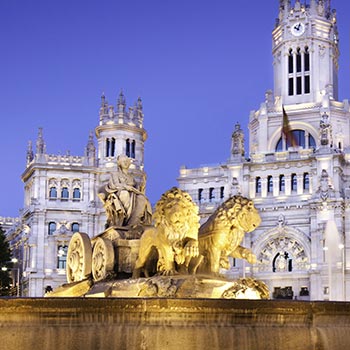Aerospace Propulsion I
Engineering & Social Sciences Program
Madrid, Spain
Dates: 8/30/25 - 12/20/25

Aerospace Propulsion I
OVERVIEW
CEA CAPA Partner Institution: Universidad Carlos III de Madrid
Location: Madrid, Spain
Primary Subject Area: Aerospace Engineering
Instruction in: English
Course Code: 14171
Transcript Source: Partner Institution
Course Details: Level 300
Recommended Semester Credits: 3
Contact Hours: 42
Prerequisites: Introduction to Fluid Mechanics, Fluid Mechanics, Thermal Engineering, Introduction to structural analysis.
We strongly advise you not to take this course if you have not passed Fluid Mechanics and Thermal Engineer
DESCRIPTION
1 Introduction to aerospace propulsion:
Thrust generation and jet propulsion
Effect of external expansion on thrust
Global performance parameters
Range of aircraft
Efficiencies
2 Aircraft Engine Modeling: the Turbojet:
Thrust equation
Shaft balance for the turbojet
Fuel consumption
Design parameters
Effect of mass flow on thrust
Note on Ramjets
Propulsive efficiency
Thermal and overall efficiencies
3 Introduction to Component Matching and Off-Design Operation
Discussion on nozzle choking
Component matching
Effects of Mach number
Examples
Compressor-turbine matching. Gas generators
4 Turbofan Engines
Ideal turbofan model
Shaft balance
Velocity matching condition
Optimal compression ratio
5 Inlets and Nozzles
Inlets or Diffusers
Subsonic Inlets
Supersonic Inlets
Exhaust nozzles
6 Principles of Compressors and Fans
Euler equation
Velocity triangles
Isentropic efficiency and compressor map . .
7 Compressor Blading, design and multi-staging
Diffusion factor. Stall and surge
Compressor blading and radial variations
Multi-staging and flow area variation
Mach Number Effects
The Polytropic Efficiency
Starting and Low-Speed Operation
8 Turbines. Stage characteristics. Degree of reaction:
Euler¿s Equation
Degree of Reaction
Radial variations
Rotating blade temperature
9 Turbine solidity. Mass flow limits. Internal cooling:
Solidity and aerodynamic loading
Mass flow per unit of annulus area and blade stress
Turbine cooling. General trends and systems. Internal cooling.
10 Film cooling. Thermal stresses. Impingement:
Film cooling
Impingement cooling
Thermal stresses
How to design cooled blades
11 Combustion: Combustors and Pollutants
Combustion process
Combustor chambers
Combustor sizing
Afterburners
Pollutants: regulations
Mechanisms for pollutant formation
Upper-Atmospheric Emissions
12 Introduction to engine noise and aeroacoustics:
Noise propagation
Acoustic energy density and power flux
Noise sources and noise modeling
Jet Noise
Turbomachinery noise
13 Engine rotating structures
Blade loads
Centrifugal stresses and disc design
14 Fundamentals of rotordynamics:
Bearings and engine arrangements
Lumped mass model
Critical speeds
Forces on bearings
Comments on blade vibrations
Thrust generation and jet propulsion
Effect of external expansion on thrust
Global performance parameters
Range of aircraft
Efficiencies
2 Aircraft Engine Modeling: the Turbojet:
Thrust equation
Shaft balance for the turbojet
Fuel consumption
Design parameters
Effect of mass flow on thrust
Note on Ramjets
Propulsive efficiency
Thermal and overall efficiencies
3 Introduction to Component Matching and Off-Design Operation
Discussion on nozzle choking
Component matching
Effects of Mach number
Examples
Compressor-turbine matching. Gas generators
4 Turbofan Engines
Ideal turbofan model
Shaft balance
Velocity matching condition
Optimal compression ratio
5 Inlets and Nozzles
Inlets or Diffusers
Subsonic Inlets
Supersonic Inlets
Exhaust nozzles
6 Principles of Compressors and Fans
Euler equation
Velocity triangles
Isentropic efficiency and compressor map . .
7 Compressor Blading, design and multi-staging
Diffusion factor. Stall and surge
Compressor blading and radial variations
Multi-staging and flow area variation
Mach Number Effects
The Polytropic Efficiency
Starting and Low-Speed Operation
8 Turbines. Stage characteristics. Degree of reaction:
Euler¿s Equation
Degree of Reaction
Radial variations
Rotating blade temperature
9 Turbine solidity. Mass flow limits. Internal cooling:
Solidity and aerodynamic loading
Mass flow per unit of annulus area and blade stress
Turbine cooling. General trends and systems. Internal cooling.
10 Film cooling. Thermal stresses. Impingement:
Film cooling
Impingement cooling
Thermal stresses
How to design cooled blades
11 Combustion: Combustors and Pollutants
Combustion process
Combustor chambers
Combustor sizing
Afterburners
Pollutants: regulations
Mechanisms for pollutant formation
Upper-Atmospheric Emissions
12 Introduction to engine noise and aeroacoustics:
Noise propagation
Acoustic energy density and power flux
Noise sources and noise modeling
Jet Noise
Turbomachinery noise
13 Engine rotating structures
Blade loads
Centrifugal stresses and disc design
14 Fundamentals of rotordynamics:
Bearings and engine arrangements
Lumped mass model
Critical speeds
Forces on bearings
Comments on blade vibrations










